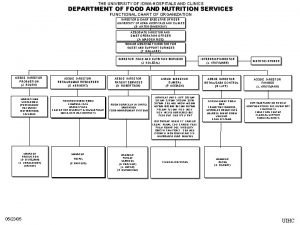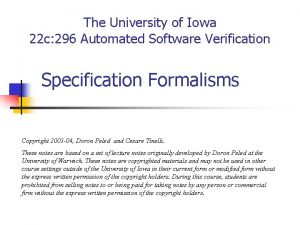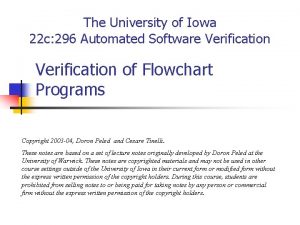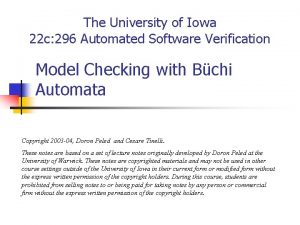The University of Iowa 22 c 296 Automated


























































- Slides: 58

The University of Iowa 22 c: 296 Automated Software Verification Modeling Software Systems for Analysis Copyright 2003 -04, Doron Peled and Cesare Tinelli. These notes are based on a set of lecture notes originally developed by Doron Peled at the University of Warwick. These notes are copyrighted materials and may not be used in other course settings outside of the University of Iowa in their current form or modified form without the express written permission of the copyright holders. During this course, students are prohibited from selling notes to or being paid for taking notes by any person or commercial firm without the express written permission of the copyright holders.

Modelling n n n Modelling: representing a system in terms mathematical objects that reflect the system’s relevant properties. Modelling often involves abstraction, to focus on main properties and manage complexity (Modelling is also required because mathematical methods cannot handle physical systems, only abstractions of them. )

Modelling n Modelling can be applied to existing systems, to reason about them after they have been built (good) n future systems, to drive the design and construction of a system, and catch errors at the model level already (better) n

Modelling n n Modelling is a subtle task. Main issues: n n n Selection of relevant properties Right level of abstraction If not done properly, verification of the model may not carry over to the actual system (missed errors, spurious errors)

Modelling and specification for verification How to specify what the software is supposed to do? n How to model it in a way that allows us to check it? n

Systems of interest n n Sequential systems. Concurrent systems (multi-threaded). 1. 2. 3. Distributed systems. Reactive systems. Embedded systems (software + hardware).

Sequential systems. n n Perform some computational task independently of other tasks. Have some initial condition, e. g. , 0 i n a[i] integer. Have some final assertion, e. g. , 0 i n-1 a[i] a[i+1]. Are supposed to terminate.

Concurrent Systems n n n Involve several computation agents. Termination may indicate an abnormal event (interrupt, error). May exploit diverse computational power. May involve remote components (Distributed). May interact with users (Reactive). May involve hardware components (Embedded).

Issues in modelling systems n Representing concurrency: n n n Granularity of transitions. n n n allow one transition at a time, or allow parallel transitions. Assignments and checks? Application of methods? Global (all the system) or local (one thread at a time) states.

Modeling. The states based model. Lexicon V={v 0, v 1, v 2, …} - a set of program variables, over some domains (might include “hidden” variables such as program counter, register, etc. ). n p(v 0, v 1, …, vn) - a parametrized assertion: a FOL formula with free variables from V n e. g. , v 0 v 1+v 2 v 3>v 4.

Modeling. The states based model. n n A state is an assignment of values to the program variables. For example: s=<v 0=1, v 2=3, v 3=7, …, v 18=2> For predicate (first-order formula) p : p(s) is p under the assignment s. Example: n n n p is x>y y>z. s = <x=4, y=3, z=5> p(s) is 4>3 3>5

State space n n The state space of a program is the set of all possible states for it. For example, if V={a, b, c} and the variables are over the naturals, then the state space includes: <a=0, b=0, c=0>, <a=1, b=1, c=0>, <a=932, b=5609, c=6658>…

State space: Formally, a triple <S, , I> where n S is a set of states n I S is a set of initial states n S S is a transition relation n each pair in is an atomic transition Interleaving model of computation

State space as automata: A state space A=<S, , I> can be also seen as an automaton A run of A of is any maximal sequence s 0, s 1, s 2, s 3, … such that n s 0 I n (si, si+1 ) for all i 0

Atomic Transitions n n n An atomic transition represents a small piece of code such that no smaller piece of code is observable. Is a: =a+1 atomic? In some systems, yes. n E. g. , when a is a register and the transition is executed using an inc command.

Non-atomicity n n n Execute the following when a=0 in two concurrent processes: P 1: a=a+1 P 2: a=a+1 Result: a=2. Really? Is this always the case? Consider the actual translation: P 1: load R 1, a inc R 1 store R 1, a P 2: load R 2, a inc R 2 store R 2, a n a may be also 1. n

Scenario P 1: load R 1, a inc R 1 store R 1, a a=0 R 1=0 R 2=0 P 2: load R 2, a R 1=1 R 2=1 inc R 2 a=1 store R 2, a a=1

Transition Systems Finite representation of a state space. Formally, a triple <S, T, > where: n S is a first-order structure of signature G=(V, F, R); n n T is a finite set of transitions (see later); is an initial condition, a qff over G.

Representing transitions Each transition has the form p (v 1, …, vn) : = (t 1, …, tn) where: n p is the enabling condition, a qff over G. n (v 1, …, vn) : = (t 1, …, tn) is the transformation, a multiple (re)assignment with n n v 1, …, vn V t 1, …, tn terms(G)

Representing transitions Examples: 1) x>y (c, d) : = (d, c) 2) x>y y>1 (x, y) : = (x-y, x-1) Semantics: 1) Enabled in states a such that s |=S x>y. Leads to a state where the values of c and d are swapped (wrt the values in s) 2) Similar.

Initial condition A quantifier free formula . The system can start only from states s such that (s) holds (that is, s. t. s |=S ) Example: = x>y (y>4 y<-2).

Transition Systems: Example n n n S = the natural numbers with the usual function and relation symbols V = {a, b, c, d, e}. T = {c>0 (c, e) : = (c-1, e+1), d>0 (d, e) : = (d-1, e+1)} = (c a d b e 0) What does this transition system do?

The interleaving model n An execution is a finite or infinite sequence of states s 0, s 1, s 2, … such that n n The initial state satisfies the initial condition, I. e. , (s 0). Moving from one state si to si+1 is by executing a transition p t : n n p(si), I. e. , si satisfies p (in the given structure). si+1 is obtained by applying t to si.

Example: T={c>0 (c, e): =(c-1, e+1), n s 0=<a=2, b=1, c=2, d=1, e=0> n s 1=<a=2, b=1, c=1, d=1, e=1> n s 2=<a=2, b=1, c=1, d=0, e=2> n s 3=<a=2, b=1 , c=0, d=0, e=3> d>0 (d, e): =(d-1, e+1)} = (c a d b e 0)

Exercise: from code to transition systems Integer Division L 1: L 2: L 3: L 4: L 5: L 6: y 1: = 0; y 2 : = x 1; while y 2 >= x 1 do y 1 : = y 1 + 1; y 2 : = y 2 - x 2; endwhile Structure: The integers Variables and their ranges: x 1, x 2, y 1. y 2: integers pc: {L 1, …, L 6} Initial condition: = PC L 1 x 2 > 0

Exercise: from code to transition systems Transitions:

Example: Concurrent Processes L 0: while True do NC 0: wait(Turn=0); CR 0: Turn : = 1 endwhile || L 1: while True do NC 1: wait(Turn=1); CR 1: Turn : = 0 endwhile Variables and their ranges Turn: {0, 1} PC 0: {L 0, NC 0, CR 0} PC 1: {L 1, NC 1, CR 1} Initial condition: = PC 0 L 0 PC 1 L 1

The transitions L 0: while True do NC 0: wait(Turn=0); CR 0: Turn : = 1 endwhile || L 1: while True do NC 1: wait(Turn=1); CR 1: Turn : = 0 endwhile T 0: PC 0 L 0 PC 0 : = NC 0 T 1: PC 0 NC 0 Turn 0 PC 0 : = CR 0 T 2: PC 0 CR 0 (PC 0, Turn) : = (L 0, 1) T 3: PC 1 L 1 PC 1 NC 1 T 4: PC 1 NC 1 Turn 1 PC 1 : = CR 1 T 5: PC 1 CR 1 (PC 1, Turn) : = (L 1, 0)

The state graph: Successor relation between states. Turn=1 L 0, L 1 Turn=0 L 0, NC 1 Turn=0 NC 0, L 1 Turn=0 NC 0, NC 1 Turn=0 Turn=1 L 0, NC 1 Turn=0 CR 0, L 1 CR 0, NC 1 Turn=1 L 0, CR 1 Turn=1 NC 0, L 1 NC 0, NC 1 Turn=1 NC 0, CR 1

Some observations n n Executions: the set of maximal paths (finite or terminating in a node where nothing is enabled). Nondeterministic choice: when more than a single transition is enabled at a given state. Necessary condition: at least one node of the state graph has more than one successor.

Verifiable(? ) Properties of a Transition System Examples: 1. Always ¬)PC 0 CR 0 PC 1 CR 1) More formally: for all reachable states s, s |=S ¬)PC 0 CR 0 PC 1 CR 1) 2. Always when Turn=0 then sometimes Turn=1 More formally: for all reachable states s s. t. s |=S Turn 0, there is a descendant state s’ s. t s |=S Turn 1

Always ¬)PC 0 CR 0 PC 1 CR 1) (Mutual exclusion) Turn=1 L 0, L 1 Turn=0 L 0, NC 1 Turn=0 NC 0, L 1 Turn=0 NC 0, NC 1 Turn=0 Turn=1 L 0, NC 1 Turn=0 CR 0, L 1 CR 0, NC 1 Turn=1 L 0, CR 1 Turn=1 NC 0, L 1 NC 0, NC 1 Turn=1 NC 0, CR 1

Always if Turn=0 then at some point Turn=1 L 0, L 1 Turn=0 L 0, NC 1 Turn=0 NC 0, L 1 Turn=0 NC 0, NC 1 Turn=0 Turn=1 L 0, NC 1 Turn=0 CR 0, L 1 CR 0, NC 1 Turn=1 L 0, CR 1 Turn=1 NC 0, L 1 NC 0, NC 1 Turn=1 NC 0, CR 1

Always if Turn=0 then at some point Turn=1 L 0, L 1 Turn=0 L 0, NC 1 Turn=0 NC 0, L 1 Turn=0 NC 0, NC 1 Turn=0 Turn=1 L 0, NC 1 Turn=0 CR 0, L 1 CR 0, NC 1 Turn=1 L 0, CR 1 Turn=1 NC 0, L 1 NC 0, NC 1 Turn=1 NC 0, CR 1

Interleaving semantics: Execute one transition at a time. Turn=0 L 0, L 1 Turn=0 L 0, NC 1 Turn=1 L 0, NC 1 Turn=0 NC 0, NC 1 Turn=1 L 0, CR 1 Turn=0 CR 0, NC 1 Need to check the property for every possible interleaving!

Interleaving semantics Turn=0 L 0, L 1 Turn=0 L 0, NC 1 Turn=0 NC 0, NC 1 Turn=0 CR 0, NC 1 Turn=1 L 0, CR 1 Turn=0 L 0, L 1 Turn=0 L 0, NC 1

Busy waiting L 0: while True do NC 0: wait(Turn=0); CR 0: Turn : = 1 endwhile || L 1: while True do NC 1: wait(Turn=1); CR 1: Turn : = 0 endwhile T 0: PC 0=L 0 PC 0: =NC 0 T 1: PC 0=NC 0/Turn=0 PC 0: =CR 0 T 1’: PC 0=NC 0/Turn=1 PC 0: =NC 0 T 2: PC 0=CR 0 (PC 0, Turn): =(L 0, 1) T 3: PC 1==L 1 PC 1=NC 1 T 4: PC 1=NC 1/Turn=1 PC 1: =CR 1 T 4’: PC 1=NC 1/Turn=0 PC 1: =NC 1 T 5: PC 1=CR 1 (PC 1, Turn): =(L 1, 0) Initially: PC 0=L 0 / PC 1=L 1

Always when Turn=0 then sometimes Turn=1 L 0, L 1 Turn=0 L 0, NC 1 Turn=0 NC 0, L 1 Turn=0 NC 0, NC 1 Turn=0 Turn=1 L 0, NC 1 Turn=0 CR 0, L 1 CR 0, NC 1 Turn=1 L 0, CR 1 Turn=1 NC 0, L 1 Turn=1 NC 0, NC 1 Turn=1 NC 0, CR 1 Now it does not hold! (Red subgraph generates a counterexample execution. )

Combining Systems

Combined State Spaces n n n State spaces can sometimes be more conveniently defined compositionally. Especially in multiprocess applications. The global state space can be constructed as a combination of the local state spaces of eac process.

State space: Recall: a triple <S, , I> where n n S is a set of states I S is a set of initial states S S is a transition relation each pair in is an atomic transition We add n A set of transition names n A labeling function L: ->

State space with labeled transitions Equivalently: Let a state space now be a triple <S, , , I> where n S is a set of states n I S is a set of initial states n is a set of transition names n S S is a labeled transition relation n each triple in is an atomic transition

Combining state spaces Let Gi = <Si, i, Ii> be a state space for i=1, 2. The combination G 1 || G 2 = <S, , , I> is the state space such that n S = S 1 S 2 n I = I 1 I 2 n = 1 2 n = {((s, r), , (s’, r)) | (s, , s’) 1, 1 2 , r S 2} {((s, r), , (s, r’)) | (r, , r’) 2, 2 1 , s S 1} {((s, r), , (s’, r’)) | (s, , s’) 1, (r, , r’) 2} mutual transitions

Combining state spaces: Example s 1 r 1 || s 2 (s 1, r 2) r 2 (s 1, r 1) (s 2, r 2) (s 2, r 1) =

Combining state spaces The asynchronous composition operator || is n commutative (in the sense that): G 1 || G 2 is isomorphic to G 2 || G 1 n associative: G 1 || (G 2 || G 3) is isomorphic to (G 1 || G 2 ) || G 3 Mutual transitions: n change the local states of both components n can be used to model a message exchange between two processes

Fairness

Dekker’s algorithm P 1: : while true do begin non-critical section 1 c 1: =0; while c 2=0 do begin if turn=2 then begin c 1: =1; wait until turn=1; c 1: =0; end critical section 1 c 1: =1; turn: =2 end. boolean c 1 initially 1; boolean c 2 initially 1; integer (1. . 2) turn initially 1; P 2: : while true do begin non-critical section 2 c 2: =0; while c 1=0 do begin if turn=1 then begin c 2: =1; wait until turn=2; c 2: =0; end critical section 2 c 2: =1; turn: =1 end.

Dekker’s algorithm boolean c 1 initially 1; boolean c 2 initially 1; integer (1. . 2) turn initially 1; P 2: : while true do P 1: : while true do begin non-critical section 1 non-critical section 2 c 1: =0; c 2: =0; while c 2=0 do c 1=c 2=0, while c 1=0 do begin turn=1 if turn=2 then if turn=1 then begin c 1: =1; c 2: =1; wait until turn=2; c 1: =0; c 2: =0; end end critical section 1 end c 1: =1; critical section 2 turn: =2 c 2: =1; end. turn: =1 end.

Dekker’s algorithm boolean c 1 initially 1; boolean c 2 initially 1; integer (1. . 2) turn initially 1; P 2: : while true do P 1: : while true do begin non-critical section 1 non-critical section 2 c 1: =0; c 2: =0; while c 2=0 do c 1=c 2=0, while c 1=0 do begin turn=1 if turn=2 then if turn=1 then begin c 1: =1; c 2: =1; wait until turn=2; c 1: =0; c 2: =0; end end critical section 1 end c 1: =1; critical section 2 turn: =2 c 2: =1; end. turn: =1 end.

Dekker’s algorithm P 1 waits for P 2 to set c 2 to 1 again. Since turn=1 (priority for P 1), P 2 is ready to do that. But never gets the chance, since P 1 is constantly active checking c 2 in its while loop. P 2: : while true do P 1: : while true do begin non-critical section 1 non-critical section 2 c 1: =0; c 2: =0; while c 2=0 do c 1=c 2=0, while c 1=0 do begin turn=1 if turn=2 then if turn=1 then begin c 1: =1; c 2: =1; wait until turn=2; c 1: =0; c 2: =0; end end critical section 1 end c 1: =1; critical section 2 turn: =2 c 2: =1; end. turn: =1 end.

What went wrong? n n The execution is unfair to P 2. It is not allowed a chance to execute. Such an execution is due to the interleaving model (just picking an enabled transition. If it did, it would continue and set c 2 to 0, which would allow P 1 to progress. Fairness = excluding some of the executions in the interleaving model, which do not correspond to actual behavior of the system. while c 1=0 do begin if turn=1 then begin c 2: =1; wait until turn=2; c 2: =0; end

Recall: The interleaving model n n n An execution is a finite or infinite sequence of states s 0, s 1, s 2, … The initial state satisfies the initial condition, I. e. , I (s 0). Moving from one state si to si+1 is by executing a transition e t: n e(si), I. e. , si satisfies e. n si+1 is obtained by applying t to si. Now: consider only “fair” executions. Fairness constrains sequences that are considered to be executions. Sequences Executions Fair executions

Some fairness definitions n Weak process fairness: Rejects executions in which a process is enabled infinitely often, but none of its transitions is ever executed. n Strong process fairness: Rejects executions in which at least one transition of a process is enabled infinitely often, but no transitions of this process are ever executed. n Weak transition fairness: Rejects executions in which a transition is enabled infinitely often, but is never executed. n Strong transition fairness: Rejects executions in which a transition is enabled infinitely often, but is never executed.

How to use fairness constraints? n n n Assume in the negative that some property (e. g. , termination) does not hold, because of some transitions or processes prevented from execution. Show that such executions are impossible, as they contradict fairness assumption. We sometimes do not know in reality which fairness constraint is guaranteed.

Example P 1: : lo: x: =1 l 1: end For P 2’s loop to terminate P 1 must execute the assignment. But P 1 will never execute, if P 2 is in a loop executing true. Consequently, x==1 never holds, and y is never assigned a 1. Initially: x=0; y=0; P 2: : r 0: while y=0 do r 1: [skip || if x=1 then y: =1 ] end pc 1=l 0 -->(pc 1, x): =(l 1, 1) /* x: =1 */ pc 2=r 0/y=0 -->pc 2=r 1 /* y==0*/ pc 2=r 1 -->pc 2=r 0 /* true */ pc 2=r 1/x=1 -->(pc 2, y): =(r 0, 1) /* x==1 --> y: =1 */

Weak transition fairness Initially: x=0; y=0; P 1: : l 0: x=1 Under weak transition fairness, P 1 would assign 1 to x, but this does not guarantee that 1 is assigned to y and thus the P 2 loop will terminates, since the transition for checking x==1 is not continuously enabled (program counter not always there). P 2: : r 0: while y=0 do r 1: [skip || if x=1 then y: =1 ] end Weak process fairness only guarantees P 2 to execute, but it can still choose to do the true. Strong process fairness: same.

Strong transition fairness Initially: x=0; y=0; P 2: : r 0: while y=0 do r 1: [skip Under strong transition || fairness, P 1 would assign if x=1 then y: =1 1 to x. If the execution was ] infinite, the transition end checking x==1 was infinitely often enabled. Hence it would be eventually selected. Then assigning y=1, the main loop is not enabled anymore. P 1: : l 0: x=1

“Weaker fairness condition” n n A is weaker than B if B ==>A. Consider the executions E(A) and E(B). Then E(B) E(A). An execution is strong {process, transition} fair ==> it is weak {process, transition} fair. There are fewer strong {process, transition} fair executions. Strong transition fair execs Strong process fair execs Weak transition fair execs
 Fastx uiowa
Fastx uiowa Uiowa hawk irb
Uiowa hawk irb Iowa state intramurals
Iowa state intramurals Studi kepemimpinan universitas iowa
Studi kepemimpinan universitas iowa Iowa state university accounts receivable
Iowa state university accounts receivable University of iowa hospital and clinics departments
University of iowa hospital and clinics departments Sona iowa state
Sona iowa state Isba mock trial
Isba mock trial University of iowa college of dentistry
University of iowa college of dentistry Iowa state math department
Iowa state math department Nnpj-296
Nnpj-296 Wac 296-307
Wac 296-307 Wac 296-155
Wac 296-155 Wac 296 305
Wac 296 305 Executari silite mihai bravu
Executari silite mihai bravu Cs 296
Cs 296 Wac 296-800-160
Wac 296-800-160 E 296
E 296 Wac 296 305
Wac 296 305 Wac 296
Wac 296 Một số thể thơ truyền thống
Một số thể thơ truyền thống Thế nào là hệ số cao nhất
Thế nào là hệ số cao nhất Trời xanh đây là của chúng ta thể thơ
Trời xanh đây là của chúng ta thể thơ Hệ hô hấp
Hệ hô hấp Các số nguyên tố là gì
Các số nguyên tố là gì đặc điểm cơ thể của người tối cổ
đặc điểm cơ thể của người tối cổ Tia chieu sa te
Tia chieu sa te Các châu lục và đại dương trên thế giới
Các châu lục và đại dương trên thế giới Glasgow thang điểm
Glasgow thang điểm ưu thế lai là gì
ưu thế lai là gì Tư thế ngồi viết
Tư thế ngồi viết Cái miệng xinh xinh thế chỉ nói điều hay thôi
Cái miệng xinh xinh thế chỉ nói điều hay thôi Các châu lục và đại dương trên thế giới
Các châu lục và đại dương trên thế giới Mật thư tọa độ 5x5
Mật thư tọa độ 5x5 Bổ thể
Bổ thể Tư thế ngồi viết
Tư thế ngồi viết Ví dụ giọng cùng tên
Ví dụ giọng cùng tên Thẻ vin
Thẻ vin Thơ thất ngôn tứ tuyệt đường luật
Thơ thất ngôn tứ tuyệt đường luật Chúa sống lại
Chúa sống lại Sự nuôi và dạy con của hổ
Sự nuôi và dạy con của hổ Từ ngữ thể hiện lòng nhân hậu
Từ ngữ thể hiện lòng nhân hậu Diễn thế sinh thái là
Diễn thế sinh thái là Vẽ hình chiếu vuông góc của vật thể sau
Vẽ hình chiếu vuông góc của vật thể sau Phép trừ bù
Phép trừ bù Tỉ lệ cơ thể trẻ em
Tỉ lệ cơ thể trẻ em Lời thề hippocrates
Lời thề hippocrates Vẽ hình chiếu đứng bằng cạnh của vật thể
Vẽ hình chiếu đứng bằng cạnh của vật thể đại từ thay thế
đại từ thay thế Quá trình desamine hóa có thể tạo ra
Quá trình desamine hóa có thể tạo ra Các môn thể thao bắt đầu bằng tiếng đua
Các môn thể thao bắt đầu bằng tiếng đua Cong thức tính động năng
Cong thức tính động năng Hình ảnh bộ gõ cơ thể búng tay
Hình ảnh bộ gõ cơ thể búng tay Khi nào hổ mẹ dạy hổ con săn mồi
Khi nào hổ mẹ dạy hổ con săn mồi Thế nào là mạng điện lắp đặt kiểu nổi
Thế nào là mạng điện lắp đặt kiểu nổi Các loại đột biến cấu trúc nhiễm sắc thể
Các loại đột biến cấu trúc nhiễm sắc thể Thế nào là sự mỏi cơ
Thế nào là sự mỏi cơ độ dài liên kết
độ dài liên kết

















































































